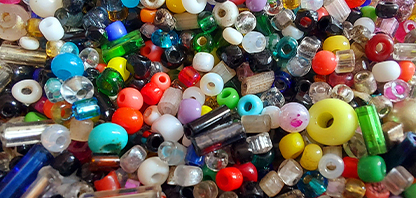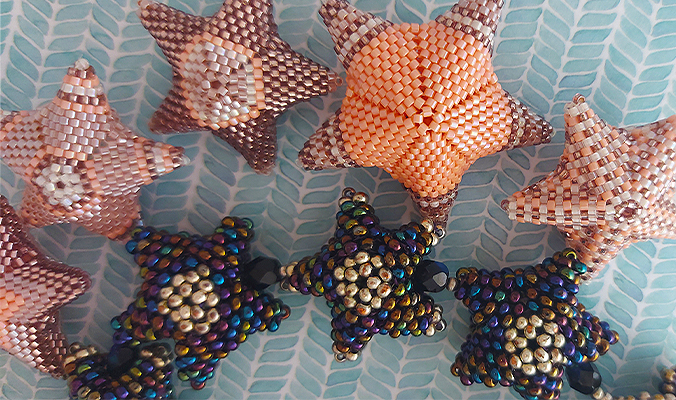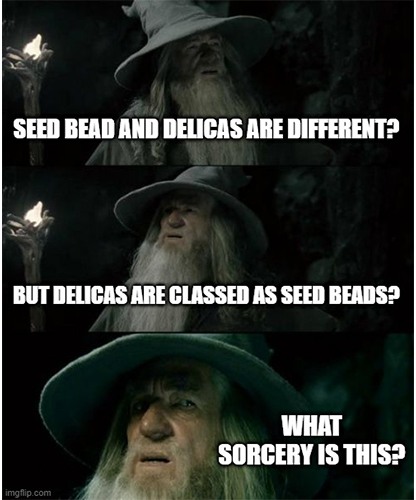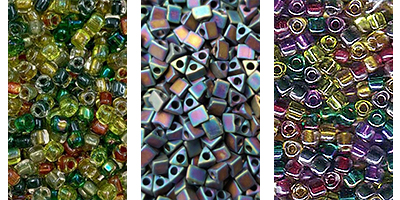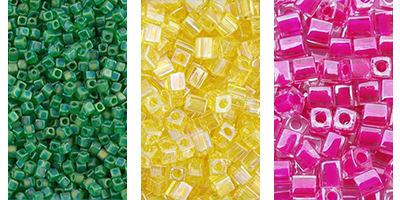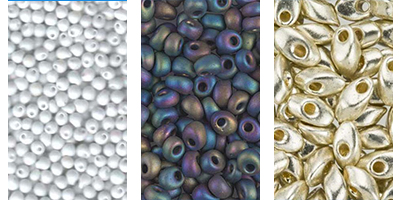| Miyuki Bead Sizes and Shapes Guide |
Stumped by the
differences between Miyuki Seed Beads and Delicas? Confused by Cut beads and
Cubes? Take heart that you're not the only one - the world of beads is immense,
with new shapes being introduced all the time.
Luckily for us,
Miyuki has produced a handy guide that shows the different shapes for each of
their beads, along with some useful information on their sizes. Included in the
guide are the types (names) of each of the Miyuki beads, with a
diagram showing the bead shape, hole shape and placement, the size of the bead,
the hole size and a sample picture of each.
*Please note: as
mentioned at the top of their page, the bead sizes are an approximate
measurement for the outside diameter and are in 'mm'.
It is important to
remember that the type of coating or plating on a bead can have an overall
effect on the bead size. For example, a bead with a 'galvanised' coating may
end up being slightly larger than a crystal silver-lined bead. Not much
difference when you're talking one bead, but if you've got a large loom-worked
piece or a peyote-stitched bracelet with a mix of beads, you'll soon see how
they can skew the line of your work.
But why is knowing
the different bead shapes important? Well, that really depends on your beading
style and preference, however, some beads lend themselves much better to
certain stitches or effects than others. Knowing which beads to start with can
really take the hassle and disappointment out of making something that doesn't
sit quite right when it's worn, isn't quite symmetrical or just doesn't match
what you had in your mind. Check out any popular social media beading forums or
listen to questions from any new beader and you'll soon see that most problems
arise from using the incorrect bead.
Here's an example
of how some Peyote-stitched stars made in exactly the same way can look and act
very differently due to the types of beads used. The iris blue stars
are made using Miyuki Seed Beads and small silver round beads in the centre,
creating a softer look and feel for the star shape. The stars themselves can be
easily squashed almost flat or plumped out by squeezing in the sides.
Conversely, the
salmon and amethyst stars are made using Miyuki Delicas, creating a much
stiffer and more uniform shape. These stars cannot easily be squashed (in fact
too much pressure would cause the stars and/or the beads to break) and are a
much better choice for creating a design that you want to keep rigid when worn. |
We've listed a few key highlights for some of the most popular beads below, but please remember these aren't hard and fast rules when it comes to working with beads. In fact, we encourage you to have a play using different beads with your favourite stitches to see what effects they make and how they can impact your design choices.
Miyuki Seed Beads and Miyuki Delica Beads
It's true! The term
'seed bead' is a generic term usually applied to any small bead, as well as
being a type of bead too - that may be where some confusion comes from.
However, the differences between the two are vast, especially when it comes to
stitching with them. Miyuki Seed Beads are also known as Rocailles (or Round
Rocailles) and are much rounder in overall shape, with soft, rounded hole
edges. Seed beads are great for more natural or flowing stitches such as
Right-Angle Weave, Daisy Chain, Netting, Chenille and Spiral Stitch. Miyuki Delicas
are also known as Cylinder
beads, as their shape is much more tubular than round. These beads are great
for tight-fitting stitches such as Peyote, Ladder, Brick, and Herringbone.
Interestingly, Seed Beads tend to be more popular for the newer
Peyote-With-A-Twist stitch, as some beaders find Miyuki Delica beads to be too
stiff. Of course, these
beads can be interchanged with each other to great effect - think Cellini
spirals. They are most useful for helping increase or decrease bezels around
Rivolis as each bead helps fill a tiny gap each time the row increases. Both Seed Beads and Delicas are
available in sizes 15/0, 11/0, 8/0, with Delicas also available in 10/0 and
Seeds available in 6/0 and 5/0.
Both types of beads
also have the 'Cut' variations (also known as 2-cut, 3-cut, Hex-cut). This is where
tiny facets are cut onto the sides of the bead for added reflection and
sparkle, without altering the overall bead size. |
Miyuki Triangles The triangular-shaped
Miyuki seed beads are available in two forms: as a standard triangle shape,
which is quite soft and rounded, or as a 'Sharp', with sharply defined corners.
These beads are great for adding texture and depth to a flat piece of beadwork,
or for creating eye-catching embellishments on spiral-stitched pieces. They can
be used in the same way as the other seed bead shapes if you want to recreate a
more organic and free-form feel to your design. |
Bugle Beads and Miyuki Twist Beads Bugles and Twists
(not to be confused with the Czech-style Twist beads that look like twisted
elongated drops) are similar in shape to each other. They are thin, tubular
beads which can vary in length and are great for fringes, beaded drops, netting
and even spiral stitching. Bugles can
be tricky to work with as the walls of the beads are thin and the holes can be
sharp. However, 'bookmarking' each end of the bead with tiny seed beads is an
easy way to combat this and add variation to your design at the same time. They
also work well in bead embroidery, for geometrical and linear designs. |
Miyuki Cubes Miyuki Cube beads (also known as Squares) are perfectly
formed little block squares that come in 3 sizes: 1.8mm, 3mm and 4mm. These
geometric beads are perfect for tight-fitting and 'locking' or 'zipping'
stitches such as Peyote, Brick and Loom-work. Think Delicas, but more 3D. They
can also add angular effects to Spiral Stitch and Cellini, however, you'll need
to consider how much the beads may protrude from the design and what impact
this might have on the wearer. Miyuki Cube beads come in an
array of colours and finishes, so it's easy to team them with the same colours
in the Seed Bead and Miyuki Delica beads range. |
Drops, Magatamas and Long Magatamas Drops and Magatamas
are both similar in shape, with a teardrop-style silhouette. The Drop bead has
a slightly 'pinched-in' tapered neck where the hole is placed, allowing the
beads to nestle in between each other. Magatama drops, by comparison, have a
smooth tapered neck that allows the beads to sit next to each other. The Long
Magatama looks like an elongated drop that has been cut on the bias, so the
bead 'leans' in a certain direction depending on how you stitch it in place.
These beads aren't
designed to be used as the main bead in off-loom beadwork (i.e. you can't
really Peyote or Right-Angle Weave with them by themselves). However, they are
great for edging beadwork, adding embellishments when 'stitching-in-the-ditch’
and for creating definition and floral effects around a bezel. The Long
Magatamas are especially good at reproducing a 'scales' effect when
stitched together - perfect if you love a reptilian or dragon-style look to
your creations. |
You can find out
more about the technical specifications of these beads and more in the Miyuki Bead Sizes and
Shapes Guide on the Miyuki beads website.
We hope you find
this guide useful for identifying the different beads when planning and
designing your own work and understanding perhaps why something didn't quite
turn out as you'd expected. Remember, an unexpected result can sometimes lead
you into a whole new world of discovery!
Bead beautifully, as always.
At CJ Beaders, we are a leading bead supplier and specialist based in Hampshire, UK. We stock a huge selection of stunning beads, including Miyuki Delicas, Seeds, and more. Shop and order online today. We offer free UK delivery for orders over £25 and order before 3pm on weekdays for same-day postage. Or visit our blog for inspiration and tips on your beading projects.

